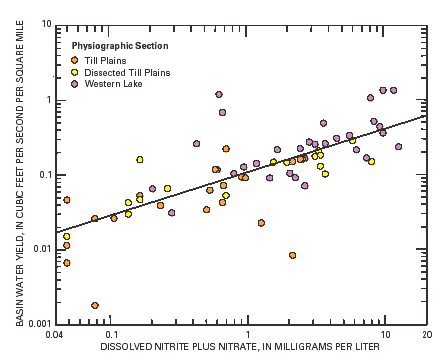
Previous Section: Introduction
Next Section: Natural Factors Influence Biological Indicators of Water Quality
Return to Table of Contents
Return to Home Page
Nutrient concentrations in water samples from Midwestern streams and rivers were not correlated with measures of agricultural intensity, such as the percentage of cropland, rates of fertilizer application, or the number of livestock in the basin. About one-half of the variance in dissolved nutrient concentrations among sites can be explained by runoff relations with rainfall. Figure 2 shows that concentrations of dissolved nitrogen increased with the amount of streamflow relative to basin drainage area (unit basin water yield). Differences in unit basin yield among streams in the Till Plains, Dissected Till Plains, and Western Lake physiographic sections (fig. 2) are associated with differences in the amount of rainfall during the month preceding the study (fig. 3). In streams with low tree density, average dissolved orthophosphorus concentrations were smaller in basins with poorly drained soils than those with moderately well drained soils (fig. 4). Although the application of nutrient fertilizers to cropland is considerable in all stream basins, nutrient concentrations vary among streams because of differences in natural factors such as riparian tree density, soil properties, and unit basin water yield.
 |
| Figure 2. Dissolved nitrogen concentrations increased with unit water yield from stream basins in August 1997, which was associated with regional differences in recent runoff. |
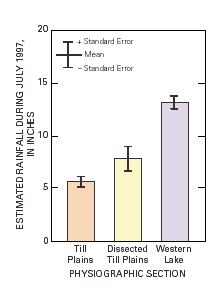 |
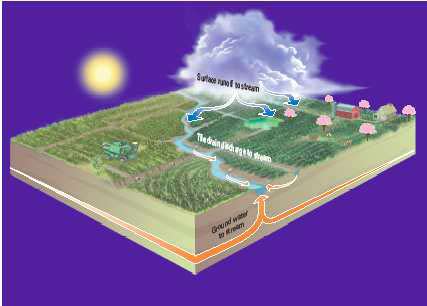 |
| Figure 3. Average rainfall in stream basins differed among physiographic sections in the upper Midwest region. |
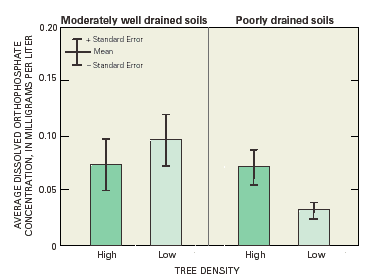 |
| Figure 4. Average dissolved orthophosphorus concentrations were smallest in streams with low tree density in basins with poorly drained soils. |
Average concentrations of suspended sediment were more than 40 percent smaller in streams with high tree density in riparian segments, but only in basins with poorly drained soils (fig. 5). Riparian zones with high tree density appeared to be effective in reducing runoff of agricultural soils into streams, particularly in the Western Lake section where soil drainage is very poor (fig. 1) and antecedent rainfall was high (fig. 3). Beneficial effects of buffers on nutrient and sediment concentrations in streams were less pronounced in sections where rainfall was relatively lower, soils were moderately well drained, and ground-water discharge contributed substantially to total streamflow.
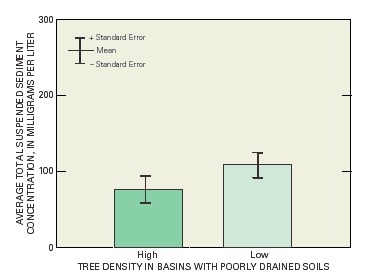 |
| Figure 5. Average concentrations of suspended sediment were smaller in streams with high riparian-tree density in buffer segments, but only in basins with poorly drained soils. |
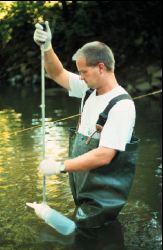 Concentrations
of herbicides in Midwestern streams were proportional to herbicide use (fig.
6; Sorenson and others, 1999); however,
relations between parent and degradation compounds differed with respect to
riparian tree density and soil conditions. Average concentrations of triazine
herbicides (for example, atrazine and cyanazine) were larger in streams with
high tree density in riparian segments (fig. 7). However,
the ratio of triazine parent to degradation compounds was largest in streams
with low tree density in basins with poorly drained soils (fig.
7), indicating slower rates of triazine herbicide degradation in those streams.
Atrazine and its degradation compounds (notably hydroxyatrazine) are retained
in poorly drained soils, such as those in the Western Lake section, because
of adsorption to clay or organic matter in soils (Lerch
and others, 1998). The use of atrazine on corn is lower in the Western Lake
section (fig. 6), possibly because of potential carryover
of atrazine in soils that could adversely affect the growth of soybeans grown
during the following season.
Concentrations
of herbicides in Midwestern streams were proportional to herbicide use (fig.
6; Sorenson and others, 1999); however,
relations between parent and degradation compounds differed with respect to
riparian tree density and soil conditions. Average concentrations of triazine
herbicides (for example, atrazine and cyanazine) were larger in streams with
high tree density in riparian segments (fig. 7). However,
the ratio of triazine parent to degradation compounds was largest in streams
with low tree density in basins with poorly drained soils (fig.
7), indicating slower rates of triazine herbicide degradation in those streams.
Atrazine and its degradation compounds (notably hydroxyatrazine) are retained
in poorly drained soils, such as those in the Western Lake section, because
of adsorption to clay or organic matter in soils (Lerch
and others, 1998). The use of atrazine on corn is lower in the Western Lake
section (fig. 6), possibly because of potential carryover
of atrazine in soils that could adversely affect the growth of soybeans grown
during the following season.
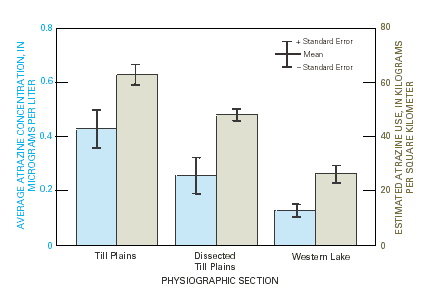 |
| Figure 6. Atrazine application rates varied among physiographic sections; stream concentrations were proportional to herbicide use. |
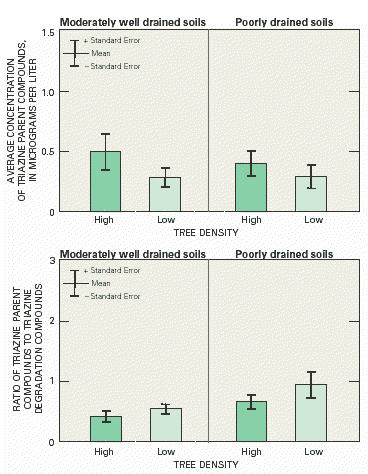 |
| Figure 7. Average concentrations of triazine herbicides were larger in streams with high tree density in riparian segments. The ratio of parent to degradation compounds was largest in poorly drained basins with low tree density. |
 |
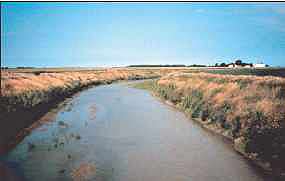 |
Average concentrations of acetanilide herbicides (for example, acetochlor and metolachlor) were also larger in streams with high riparian tree density (fig. 8) and, consequently, greater shading. Acetanilide parent-to-degradation compound ratios were larger in streams with high riparian tree density, indicating that rates of degradation are slower in shaded streams, regardless of soil-drainage conditions. Previous research has suggested that photolysis (degradation by sunlight) may be an important process by which herbicide parent compounds are broken down into compounds that are presumed to be less toxic (Kolpin and Kalkhoff, 1993; Torrents and others, 1997). Rates of acetanilide herbicide degradation may be inhibited by canopy shading in streams with high riparian tree density. However, average acetanilide parent-to-degradation compound ratios (less than 0.04; fig. 8) were an order of magnitude less than those for triazine herbicides (greater than 0.4; fig. 7), possibly indicating that acetanilide herbicides degrade more rapidly than triazine herbicides.
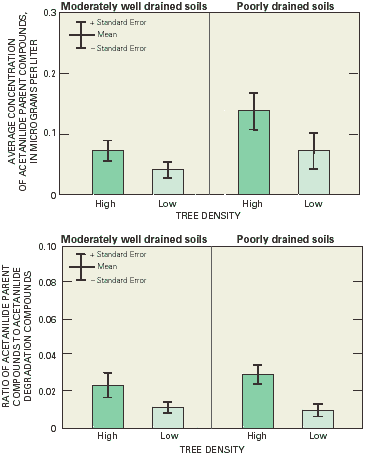 |
| Figure 8. Average concentrations of acetanilide herbicides, as well as parent-to-degradation compound ratios, were larger in streams with high tree density in riparian segments. |
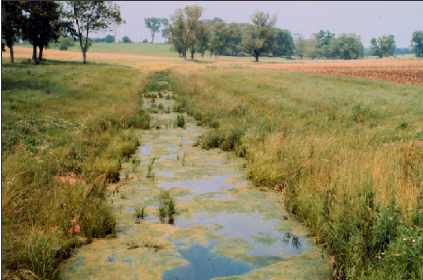
| AccessibilityFOIAPrivacyPolicies and Notices | |
 |
|